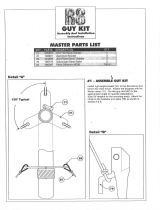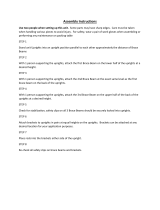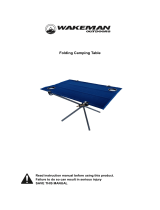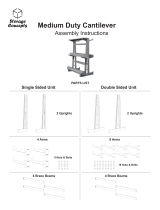Page is loading ...

40’ Wide Gabled End System
Quality, Craftsmanship and Service since 1892
NAV40Gbl-1104
Copyright © Anchor Industries 2004
Please read all assembly / installation instructions before the installation or removal of this product.
1100 Burch Dr., Evansville, IN 47725
Ph. 812-867-2421 • Fx. 812-867-0547
E-mail: [email protected] • www.anchorinc.com
Navi-Trac
ANCHOR
FRAME TENT SYSTEM
5.0”
2.3”

TABLE OF CONTENTS
Page No. Assembly Step
3 Introduction with Frame Terminology Illustration
4 Component Illustrations
5 40’ Navi-Trac Component List Table
6 40’ Navi-Trac Component List Table Cont’d
7 Safety Guidelines
8 Squaring the Tent Footprint Layout and Diagonals Chart
9 Assembling the first Beam
Assembly Layout of all Beams (Butterflying First Two Beams)
10 Erecting the First Beam and Stabilizing the First Beam
Erecting the Second Beam
11 Connecting the First Two Beams
Installing Purlins
Completing First Bay
12 Completing the Top Frame
Installing the Gabled End Frame
Guying Out the Completed Frame
13 Installing the Mid Panels and Gabled End Panels
Tensioning Fabric Panels
14 Completing the Gabled End Unit
Alternate Hip End/ Gabled End Configuration
15 Combining Hip and Gabled End Assembly Steps
Component Changes for Hip/ Gabled End Configuration
16 Limits of Liability
2

3
40’ Gabled Navi-Trac Frame Terminology
INTRODUCTION:
Like the hip-end version, the gabled end NAVI-TRAC frame is made up of extruded aluminum members joined
by weldments. The aluminum frame members themselves are extruded with channels into which the NAVI-
TRAC fabric “kedar” is fed. However, the gabled end version of the Navi-Trac differs from the Hip End version
in a number of ways:
1. All the beams are parallel to each other.
2. Beam base plates are hinged for pivoting to a vertical position. End Upright plates are fixed, non-pivoting.
3. The eave fittings are the MCW style that allows a simple drop-in action for purlin installation, rather
than the slip joint of the hip end configuration.
4. Fabric middle bays are installed into the channels of adjacent beams one bay at a time.
5. Gabled End fabric is intalled simply into the outer channel of the end beams and tensioned to the
Gabled End uprights.
6. X-Cabling extends into the overhead rafter area to compensate for the lack of hip end support.
7. Corner guys are in one direction only, parallel to the beams.
It is possible to combine the hip end and gabled end styles within one building unit (see kit #3); however
this assembly manual focuses on the gabled end configuration only. The last few pages describe the
hip/gabled combination and refer the customer to the hip end assembly manual for the hip end part of
the building unit.
R21-9
P1, P2 OR P3
(OPTIONAL)
U8
BHW
RWE
RW
G
T-42
X-4, 5 or 6
(OPTIONAL
BAY SPACING)
X-1, 2 or 3
(OPTIONAL BAY
SPACING
MCW
X-7, 8 or 9
(OPTIONAL
BAY SPACING)
EE10
ER10, 15, 0R 20
(OPTIONAL)
BFW
T-30
EW15
U8
XRB
MCW
B3
UGT
UG-15
GRW
P1
B4
See Component List Table on
Pages 5 & 6 for component
descriptions.

40’ NAVI-TRAC COMPONENT ILLUSTRATIONS
4

40’ NAVI-TRAC COMPONENT LIST
A MINIMUM GABLED UNIT CONSISTS OF (1) KIT #1, (1) KIT #2 AND (2) EXTENSION MIDS.
TO EXTEND THE LENGTH FURTHER, SIMPLY ADD ADDITIONAL EXTENSION MIDS.
STARTER MIDS ARE REQUIRED WITH HIP ENDS ONLY.
I.D. 40’ GABLED END NAVI-TRAC
LABEL
(LETTER ON
DRAWING)
COMPONENT DESCRIPTION
CODES
(STAMPED OR
TAPED)
GBL
KIT
1
GBL
KIT
2
HIP
KIT
3
20’
MID
STR
20’
MID
EXT
15’
MID
STR
15’
MID
EXT
10’
MID
STR
10’
MID
EXT
EXTRUSIONS W/CHANNELS
E20
EAVE - FEMALE 20’
4
ER10
EAVE/RIDGE - DROP-IN 10’
3 3
ER15
EAVE/RIDGE - DROP-IN 15’
3 3
ER 20
EAVE/RIDGE - DROP-IN 20’
3 3
EE-10
EAVE/GABLED END, DROP-IN 10’
1 1
EW-15
EAVE/GABLED END, DROP-IN 15’
2 2
H21-4
HIP LOWER SPLICE 21-4 (2 pc) 21’-4 (40’)
2
H7-6
HIP UPPER SPLICE (2PC) 7’-6 (40’)
2
R21-9
RAFTER 21’-9
2 1 2 2 2 2 2 2
BRACES
B1
BRACE, HIP 14’ (W/LANYARDS)
4
B3
BRACE, RIDGE 7’
1 1 1 1 1 1
B4
BRACE, UPRIGHT, 5’
1 2 2 2 2 2 2
PURLINS
P1
PURLIN 10’
2 2 2 2
P2
PURLIN 15’
2 2
P3
PURLIN 20’
2 2
UPRIGHTS
U8
UPRIGHT - 8’
2 3 2 2 2 2 2 2
UG-15
END UPRIGHT - 14’-2”
2 2
WELDMENTS, FITTINGS & PLATES
BFW
ADJ. BASE PLATES W/INSERTS (FIXED)
“END” 2 2 3 2 2 2
BHW
ADJ BASE PLATEW/INSERTS (HINGED)
2 2 2 2 2
CW
CORNER WELDMENTS
2
EIW
END INTERMEDIATE WELDMENTS
1
MLW
MID LEFT WELDMENTS
2 2 2
MRW
MID RIGHT WELDMENTS
2 2 2
MCW
MID CENTER WELDMENTS
2 2 2 2
RW
PEAK/RIDGE WELDMENT
1 1 1 1 1 1
RWE
GABLED END RIDGE WELDMENT
1 1
GRW
GABLED END UPRIGHT RAFTER WELD.
2 2
UGT
GABLED END UPRIGHT TOP INSERT
2 2
XRB
X-CABLE RAFTER BRACKET
8 8
TFW
TOP FITTING (END RAFTER) W/HDWR
1
EFW
END FITTING (HIP/INT. RAFTER) W/HDWR
4
5
CONTINUED ON NEXT PAGE

6
I.D. 40’ GABLED END NAVI-TRAC
LABEL
(LETTER ON
DRAWING)
COMPONENT DESCRIPTION
CODES
(STAMPED OR
TAPED)
GBL
KIT
1
GBL
KIT
2
HIP
KIT
3
20’
MID
STR
20’
MID
EXT
15’
MID
STR
15’
MID
EXT
10’
MID
STR
10’
MID
EXT
STAKES, CABLES & WEB GUYS
**OPTIONS OF 10’,15’, OR 20’ BAYS MUST
BE SPECIFIED.
G
NAVI-TRAC WEB GUYS
2 5 2 2 2 2 2 2
T-30
1” x 30” STEEL STAKES
2 3 2 2 2 2 2 2
T-42
1 1/8” x 42” STEEL STAKES
2 5 2 2 2 2 2 2
X-1
UPRIGHT X-CABLES FOR 10’ MID BAY**
GREEN
NAV-BAY10-U8
[4] [4]
INSTALL AS SPECIFIED FOR
UNITS 100’ +
X-2
UPRIGHT X-CABLES FOR 15’ MID BAY**
GREEN
NAV-BAY15-U8
[4] [4]
INSTALL AS SPECIFIED FOR
UNITS 100’ +
X-3
UPRIGHT X-CABLES FOR 20’ MID BAY**
GREEN
NAV-BAY20-U8
[4] [4]
INSTALL AS SPECIFIED FOR
UNITS 100’ +
X4
LOWER ROOF X-CABLES FOR 10’ MID BAY
A**
RED
NAV-BAY10
4 4
X5
LOWER ROOF X-CABLES FOR 15’ MID BAY
A**
RED
NAV-BAY15
4 4
X6
LOWER ROOF X-CABLES FOR 20’ MID BAY
A**
RED
NAV-BAY20
4 4
X7
UPPER ROOF X-CABLES FOR 10’ MID
BAYB**
BLUE
NAV40-BAY10
4 4
X8
UPPER ROOF X-CABLES FOR 15’ MID BAY
B**
BLUE
NAV40-BAY15
4 4
X9
UPPER ROOF X-CABLES FOR 20’ MID BAY
B**
BLUE
NAV40-BAY20
4 4
BOLTS AND HARDWARE
LANYARD ASS’Y W/HAIRPIN COTTER
4
1/2”-13 x 3” BOLT W/NYLOCK NUT
6 4 10 2 2 2 2 2 2
1/2”-13 x 3 1/2” BOLT W/NYLOCK NUT 6 6
INSTALLATION TOOLS
CROSS CABLE FOR 40’
BLUE 1 1 1 1 1 1
LOWER SAFETY STRAP W/RATCHET
4
UPPER SAFETY STRAP FOR 10’ BAYS
4
UPPER SAFETY STRAP FOR 15’ BAYS
4
UPPER SAFETY STRAP FOR 20’ BAYS
4
1/2” GRAVITY PIN (FOR CROSS CABLE)
2 2 2 2 2 2
LONG LIFTING CRADLE
1
PUSH POLE EXT. (FOR LONG CRADLE)
1
SHORT LIFTING CRADLE
1
ADJ. BASEPLATE GUIDE BAR
2
FABRIC PULL ROPES
2
WHEELED PANEL GUIDES
2
DROP CLOTH (8’ x 30’)
1
40’ NAVI-TRAC COMPONENT LIST
CONTINUED FROM PREVIOUS PAGE

7
NAVI-TRAC INSTALLATION SAFETY GUIDELINES
Your installation techniques will evolve to fit the needs of your clients, the experience level of your crews, the
nature of other tentage on-site, and the equipment that you have most readily available. We encourage you to
begin with a crew of (4) workers and only reduce this number as your experience level allows you to do so
safely
. Whatever techniques you adapt for your crews, we encourage you to keep safety utmost in mind.
Please read through this assembly manual completely before beginning your installation. Be sure the proper
equipment, crew and safety precautions are in place. We hope that you enjoy the design features of the NAVI-
TRAC each time the unit is installed.
1. It is recommended that workers wear safety shoes and hard-hats on site.
2. When moving beam sections by hand, use proper lifting techniques to protect the back, and
avoid pinching fingers while making hardware connections.
3. Never permit bystanders or uninvolved to stand or walk even briefly in the falling path of a beam as it is
being raised or lowered.
4. Be aware to avoid contact of beams with any overhead power lines near the site.
5. When anchoring the structure, avoid all underground power lines and gas lines or other utility
easements. Local authorities should be able to map the location of these obstacles.
6. Keep site clear of debris to avoid tripping, especially while carrying components or bundles of fabric.
7. Do not drag bundles of fabric on concrete, asphalt, or ground as this can cause damage to the
fabric from abrasion through the bag.
8. When lifting the NAVI-TRAC Hip End frame (See Appendix), be sure to use the heavy duty NAVI-TRAC
frame lift. The standard Anchor frame lift was not designed for the weight of the NAVI-TRAC frame.
When lifting each side of an end section, (2) NAVI-TRAC frame lifts should be used.
9. Before pivoting beams to vertical, clear the area
of items that could cause tripping or slipping.
10. Before pivoting middle beam, install the cross-cable for safety bracing. On the 50’ NAVI-TRAC, the
cross-cable should be left in place as an essential part of the structure.
11. NOTE: Hinged baseplates are used on all beams in the Gabled End Configuration. However, if the Hip
End is constructed on either, or both ends of the unit, the base plates in the hip end module should all be
the non-pivoting, fixed plates. Use of hinged baseplates in the end module could cause the end module
to collapse during installation.
12. When using ladders to make peak connections, be sure the ladder is tall enough that workers can
reach the peak from a ladder step consistent with the safety recommendations for the ladder being
used. On middle beams, secure the eaves before climbing the ladder to secure the peak.
13. For any Gabled End NAVI-TRAC of 100 ft or more in length, one middle bay must be cross-cabled both
in the over head and at ground level in an “X” fashion on both sides for each 100 ft of length.
14. For proper loading and anchoring information, consult the appropriate NAVI-TRAC blueprint available
from Anchor Industries Inc.
15. If a Hip End is used on either end of the unit, before installing fabric, verify that all hip, brace, and rafter
pins are seated into weldment fittings and secured by lanyard pins.
16. The installation method described herein requires coordination of tasks between workers. A
safe installation is dependent on alertness and coordination.
17. Before lifting Gabled End top frame to install uprights, always guy out and stake at least both corners
of the side or end being lifted. This will help maintain the intended footprint and will protect against uplift
from the wind that could move or flip the tent, causing damage to the tent and/or severe injury to
workers.

DIRECTIONS FOR SQUARING THE TENT
1. USE A TAPE MEASURE TO MARK THE ENDS OF A LINE FOR ONE END (A TO B ABOVE) EQUAL TO THE EXACT WIDTH OF THE UNIT.
2. HOLD THE “0” END OF ONE TAPE AT POINT “A” AND THE “0” END OF ANOTHER TAPE AT POINT “B”.
3. EXTEND THE FIRST TAPE ALONG ONE SIDE OF THE UNIT TO A MEASUREMENT EQUAL TO THE EXACT LENGTH OF THE TENT.
4. CONSULT THE CHART BELOW TO FIND THE DIAGONAL FOR THE TENT YOU ARE BUILDING.
5. EXTEND THE SECOND TAPE TO A MEASUREMENT EXACTLY EQUAL TO THIS DIAGONAL.
6. BRING THE TWO TAPES TOGETHER SO THAT THE LENGTH MEASUREMENT OF ONE LIES DIRECTLY ON THE DIAGONAL MEASUREMENT OF THE
OTHER. PULL THE TAPES TIGHT AND MARK THEIR INTERSECTION. THIS WILL LOCATE A FAR CORNER (POINT “D” ABOVE).
7. SWITCH TAPES SO THAT TAPE 1 (ABOVE) MEASURES THE DIAGONAL AND TAPE 2 (ABOVE) MEASURES THE LENGTH. THIS WILL LOCATE POINT
“C” ABOVE.
8. WITH THE FOUR PRIMARY CORNERS LOCATED, LAY OUT BASEPLATES AND UPRIGHTS ACCORDING TO THE NUMBER OF BEAMS TO BE INCLUDED
IN THE BUILDING UNIT. MEASUREMENTS GIVEN ARE TO THE CENTER OF THE STAKE HOLE OF EACH PLATE.
LENGTH OF TENT
DIAGONALS FOR SQUARING FOOTPRINT
DIAGONAL SHOWN IN FEET-INCHES (TO NEAREST INCH) - - TO CENTERS OF STAKE HOLES
WIDTH OF TENT
WIDTH OF TENT
LENGTH OF TENT
SQUARING THE TENT FOOTPRINT LAYOUT
LOCATING
THE FOUR
PRIMARY
CORNERS
DIAGONAL
A
B
C
D
8
DIAGONALS MEASURED TO
CENTER OF STAKE HOLE.
(STAKE HOLE TO
STAKE HOLE.)

9
1
3
4
2
6
5
CONSTRUCT FIRST BEAM
LAYOUT OF ALL BEAMS
MCW
RW ON MID BEAMS, RWE ON END BEAMS
R21-9
U8
BHW
T-30
XRB FOR
(X-CABLED
BEAMS ONLY)
MAKE CONNECTIONS IN NUMBER SEQUENCE
SHOWN. STAKE PLATES BEFORE ERECTING.
7
8
9
10
FIRST (2) BEAMS BUTTERFLIED SO
THAT ADJACAENT BASE PLATE STAKES
CAN BE USED FOR SAFETY GUYING.
(2ND BEAM WILL BE RAISED FIRST.)
ADJUST BASE PLATE GUIDE BARS FOR
PROPER SPACING AND ALIGNMENT OF
BASEPLATES. (DROP BAR FITTING OVER
PINS IN BASE PLATES.)
CROSS CABLE USED FOR SQUARING
FIRST BEAM BEING RAISED. OPTIONAL
ON OTHER BEAMS. NOT REQUIRED
FOR FINAL UNIT CONFIGURATION.
UPPER ENDS OF ALL X-CABLES
INSTALLED BEFORE BEAMS ARE
RAISED.
ALL PLATES ARE STAKES
WITH T-30
B3
GRW
B4
17
16
15
14
13
12
11
18
(B3 FOR USE ON MIDDLE
BEAMS ONLY. NOT USED WITH
GABLED END FRAMING.)
USE CROSS CABLE AS AN INSTALLATION TOOL TO
SQUARE FIRST BEAM BEING RAISED. OPTIONAL
ON OTHER BEAMS, DEPENDING ON TERRAIN. NOT
REQUIRED FOR FINAL 40’ CONFIGURATION.
2-PC SAFETY WEBS:
1. LOOP (4) LOWER SAFETY WEBS OVER
STAKE HEADS OF THE ADJACENT BASE
PLATES, BEAMS 1 & 3 (RATCHET ENDS UP).
2. CHOOSE (4) UPPER SAFETY WEBS
LABELED FOR 10’, 15’, OR 20’ BAY SPACING,
AS NEEDED FOR YOUR UNIT.
3. ON THE TRAILING WEBS (TO BEAM #3),
INSERT THE LOOSE, HANGING ENDS OF
UPPER WEBS INTO THE RATCHETS OF THE
LOWER SAFETY WEBS. PULL ABOUT 1 FT OF
WEB THRU THE RATCHET. LEAVE PLENTY OF
SLACK.
4. SNAP UPPER ENDS OF UPPER WEBS TO
THE EAVE BRACKETS OF THE BEAM TO BE
RAISED.
5. LEAVE THE LEADING WEBS (TO BEAM #1)
LOOSE AND HANGING UNTIL BEAM IS UP.
CAUTION: BRACES
REQUIRED TO AVOID
FRAME DAMAGE!!

10
ERECTING 2nd BEAM 1st
SECURING THE 1st BEAM SAFELY
ERECTING THE 2nd BEAM
WORKERS LIFT FIRST AT THE
PEAK, THEN SHUFFLE SIDEWAYS
TOWARD THE UPRIGHTS.
AS THE 2ND BEAM PIVOTS
TOWARD VERTICAL, THE
TRAILING SAFETY WEBS
DRAW TIGHTER.
USING RATCHETS, ADJUST LEADING AND
TRAILING SAFETY WEBS AGAINST EACH
OTHER ON BOTH SIDES OF THE STRUCTURE
TO SECURE AND VERTICALLY ALIGN THE
BEAM
WITH 2nd BEAM SECURED BY SAFETY WEBS, THE
1st BEAM IS ROTATED TOWARD IT. (2) OR (3)
WORKERS SHOULD HOLD THE BEAM AT VERTICAL
UNTIL EAVE BARS (ER20) ARE INSTALLED (SEE
NEXT STEP).
ATTACH PUSH POLE EXTENSION TO
TOP OF THE LONG LIFTING POLE.
HOOK INTO PEAK WELDMENT BRACKET
& TWIST TO SECURE. THIS WORKER
CONTROLS PEAK DURING ERECTION.
ON THE LEADING 2-PC SAFETY WEBS, WORKERS
INSERT LOOSE ENDS OF UPPER SAFETY WEBS INTO
THE RATCHETS OF THE LOWER SAFETY WEBS.

11
SECURING THE 2nd BEAM WITH
DROP-IN RIDGE/EAVE BARS
INSTALLING PURLINS AND RIDGE BARS
COMPLETING THE 1ST BAY
IN 20’ MID BAYS ONLY, INSTALL A SUPPORT PURLIN
BETWEEN THE EAVE AND THE PURLIN AT THE MID-RAFTER
LOCATION. THIS SUPPORT WILL BRACE AGAINST INWARD
DEFLECTION OF THE EAVE BAY THAT COULD OTHERWISE
RESULT IN WATER PONDING IN THE 20 FT BAY.
USE LIFTING CRADLES TO
POSITION 2nd END.
DROP-IN RIDGE/EA
VE BARS
CONNECT 1st AND 2nd BEAMS.
DROP ONE HOOK END OF
BAR INTO EAVE FITTING.
USE SAME TECHNIQUE AS ABOVE AND
THE LONG LIFTING POLE WITH CRADLE
TO INSTALL THE PURLINS AND RIDGE
EAVE BAR (AT THE PEAK)
REMOVE CROSS-CABLE FROM 2ND BEAM

12
COMPLETING THE TOP FRAME
INSTALLING GABLED END FRAME
INSTALLING GUY WEBS BEFORE INSTALLING FABRIC
STAKING DISCLAIMER: DUE TO VARYING SOIL CONDITIONS AT
EACH INSTALLATION SITE, THE STAKES PROVIDED MAY NOT
MEET THE LOADING REQUIREMENT SHOWN ON THE BLUEPRINT
AND ENGINEERING ANALYSIS. IT IS THE INSTALLERS RESPON-
SIBILITY TO VERIFY THE SOIL CONDITIONS AND PROPER
ANCHORING DEVICES REQUIRED AT EACH SITE TO ENSURE A
SAFE INSTALLATION.
ATTACH GUY WEBS TO EAVE WELDMENTS AND STAKE OUT
AT A 45 DEGREE ANGLE (DISTANCE OUT = HEIGHT OF UPRIGHT,
USUALLY 8 FT. USE 42” STAKES PROVIDED.
STAKE PLATES AT PROPER SPACING
BEFORE INSTALLING THE X-CABLES.
THEN, ADJUST TURNBUCKLES UNTIL
CABLE IS SNUG
X-CABLED BAYS
X-CABLING FROM EAVE TO BASEPLATE (AS
SHOWN) ON BOTH SIDES OF THE STRUCTURE.
SUBSTITUTE BOLTS FOR PINS AT THE TOP OF BOTH
UPRIGHTS. THREADS SHOULD POINT INWARD
TOWARD EACH OTHER. THREAD CABLE EYENUTS
ONTO EACH BOLT TO SECURE THE CABLE.
NAVI-TRAC UNITS 100 FT OR MORE IN LENGTH
MUST HAVE AN X-CABLED BAY (NEAR THE MID-
DLE AND/OR EVENLY SPACED) FOR EVERY 100
FT OF LENGTH.
REMOVE THE NUTS FROM THE BOLTS THAT PIN THE
BASEPLATE TO THE UPRIGHT. TURN THE BOLTS SO
THAT THE THREADS ARE TO THE INSIDE (FACING
EACH OTHER). THREAD THE CABLE EYENUTS ONTO
THE BOLTS TO SECURE THE CABLE.
11-T-a
REPEAT PREVIOUS STEPS UNTIL ALL
BEAMS ARE VERTICAL AND BOTH
END BAYS ARE X-CABLED, AS SHOWN.
INSTALL GABLED END FRAME. MAKE
CONNECTIONS IN THE ORDER SHOWN.
UG-15
1
EW-15
BFW
T-30
2
3
4
5
7
10
9
8
6
EE-10

13
INST
ALLING MID PANEL
PULL MID PANEL UP AND OVER THROUGH
CHANNELS IN RAFTER EXTRUSIONS.
WHEELED PANEL
GUIDE
RAFTER
INSERT FINGERS OF WHEELED PANEL GUIDE
INTO THE OPEN END OF THE RAFTER AND
WELDMENT. TIGHTEN THE BUTTERFLY NUT.
REVERSE FOR OPPOSITE SIDE OF BAY.
F
ABRIC TENSIONING
1. USE WEB/ RATCHETS TO SECURE CATENARY ARCHES TO
UPRIGHTS, STAKE BASEPLATES BEFORE TENSIONING WEBS.
ATTACH WEB/RATCHET
TO TRIANGLE RING AND
TENSION DOWNWARD.
TENSIONING
WEB (RIGHT)
W/ RING
CATENARY
TAILS
TENSIONING RINGS
OVERLAPPED
TOP
TENSIONING
WEB (LEFT)
W/ RING
UPRIGHT
WEB/RATCHET
TENSIONING METHOD
:
1. PASS RING OF LEFT TENSIONING WEB THROUGH OPPOSITE
CATENARY RING.
2. PASS RING OF RIGHT TENSIONING WEB THROUGH ITS OWN
CATENARY RING (PASSING OVER THE LEFT WEB).
3. CONTINUE RING OF RIGHT TENSIONING WEB THROUGH
OPPOSITE CATENARY RING.
4. OVERLAP BOTH TENSION RINGS. ATTACH WEB/RATHCET
AND TENSION DOWNARD AGAINST TENSION HOLE IN
UPRIGHT. (CATENARY RINGS SHOULD MOVE CLOSER
TOGETHER AS RATHCET IS TIGHTENED.)
INSTALLING 2-PC GABLED END
USE LONG LIFTING
POLE TO PUSH EACH
HALF TO PEAK.
WHEELED PANEL
GUIDE AT EAVE
SECURE LACE LINE AT TOP &
BOTTOM WITH FASTEX BUCKLES
TIE OFF BOTTOM
LOOP
STANDARD LOOP &
GROMMET LACING

14
COMPLETED 40’ GABLED END NAVI-TRAC WITH
FABRIC INSTALLED AND TENSIONED, GUY
WEBS STAKED AND RATCHETED TIGHT. TO
MEET ENGINEERING REQUIREMENTS WALLS
SHOULD BE INSTALLED ON ALL (4) SIDES.
40’
x 80’ GABLED END NAVI-TRAC
ALTERNATE HIP/GABLED END COMBINATION
USING KIT #3 FOR THE HIP COMPONENTS (SEE
PAGE 14 FOR ASSEMBLY REFERENCE)

15
HIP/GABLED END COMBINA
TION UNIT
SEE THE STANDARD NAVI-TRAC
INSTALLATION INSTRUCTIONS FOR
ASSEMBLY OF THE HIP END UNIT.
EXTENSION BEAMS ARE PIVOTED
IN THE SAME MANNER AS SHOWN
ABOVE IN THIS GABLED END
ASSEMBLY INSTRUCTION.
SEE BELOW FOR COMPONENTS
THAT MUST BE SUBSTITUTED IN
HIP END UNIT (SEE KIT #3)
E20
EIW
CW
BFW
H21-4
MRW
EFW
TFW
MLW
HIP (KIT #3) COMPONENTS
(NOTE: MRW & MLW ARE SUPPLIED
WITH THE “STARTER’ FRAMES)
E20
H7-6
R21-9
B1
BFW
B4

EVANSVILLE, INDIANA
28.3 11-01-02
Thank you for purchasing an Anchor product. In return, we pledge Quality, Service and
Craftsmanship and are available for any questions you may have or assistance you may need.
PHONE NUMBER
812-867-2421
FAX NUMBER
812-867-0547
Anchor products are of superior design and operate best within the parameters of these
instructions. It is IMPERATIVE that the instructions be carefully read and COMPLETELY
FOLLOWED. Please read installation instructions before the installation or removal of this
product. Installation instructions are available at www.anchorinc.com.
CAUTION
1. For each installation, the installer is solely responsible for evaluating the site and the prop-
er securing method determined. Some soils require different staking or securing than that
provided with the tent. Due to this variety of soil conditions, these are the manufacturer’s
suggested sequence of installation procedures. Anchor’s responsibility is limited to the con-
struction of the tent. We are not responsible for methods that installers may choose to
secure the tent to the ground.
2. Inasmuch as the weather is unpredictable, good judgment and common sense must be
incorporated within installation guidelines. It is the responsibility of the tent Installer/maintain-
er to determine the severity of the weather, proper time and method of installation and/or
erection and disassembly.
The structure has been manufactured to meet code requirements. For the safety of all occu-
pants, evacuation is recommended if inclement weather occurs, or if there is any doubt con-
cerning the safe use of this product.
3. Proper safety equipment should be used at all times to insure a safe installation and take
down. We suggest a careful evaluation be made to determine safety equipment needed,
such as hard hats, steel-toe shoes, safety glasses and other as required.
4. Anchor stands behind its products in accordance with its standard Terms and Conditions
of sale. A copy of our Terms and Conditions of Sale can be obtained by contacting Anchor at
the telephone number and/or address on this document.
/





